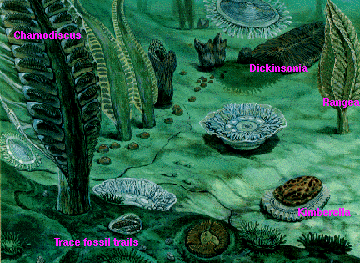The Lipalian Interval Revealed

Intense work by many groups of geologists and paleontologists in sedimentary
sections around the Neoproterozic/ Cambrian Boundary in Namibia, Russia,
Mexico and the North West Territories in Canada, combined with startling
advances in molecular biology, is assembling a history of the "Lipalian
interval", the latest Proterozic.
Around 600 million years ago, simple discs, probably Ediacaran-type animals,
appear. The oldest wormlike traces found so far date from 565 million years
ago. 565 Ma is also the date for the appearance of more complex, larger
Ediacaran organisms.
The frond-like organisms are may be ancestors
to modern sea pens. Cnidarians, the family including anemones and corals,
may be linked to some of the disk-shaped Ediacaran creatures.
Simple traces occur in the sediments dated ~565 Ma. Later, traces that could
only have been made by creatures with complete guts and the capacity to
displace sediment also appear in the Neoproterozoic fossil record. Recently discovered Kimberella
could have made such traces.
Detail of painting by D.W. Miller from American Scientist, March-April, 1997. Labels added




